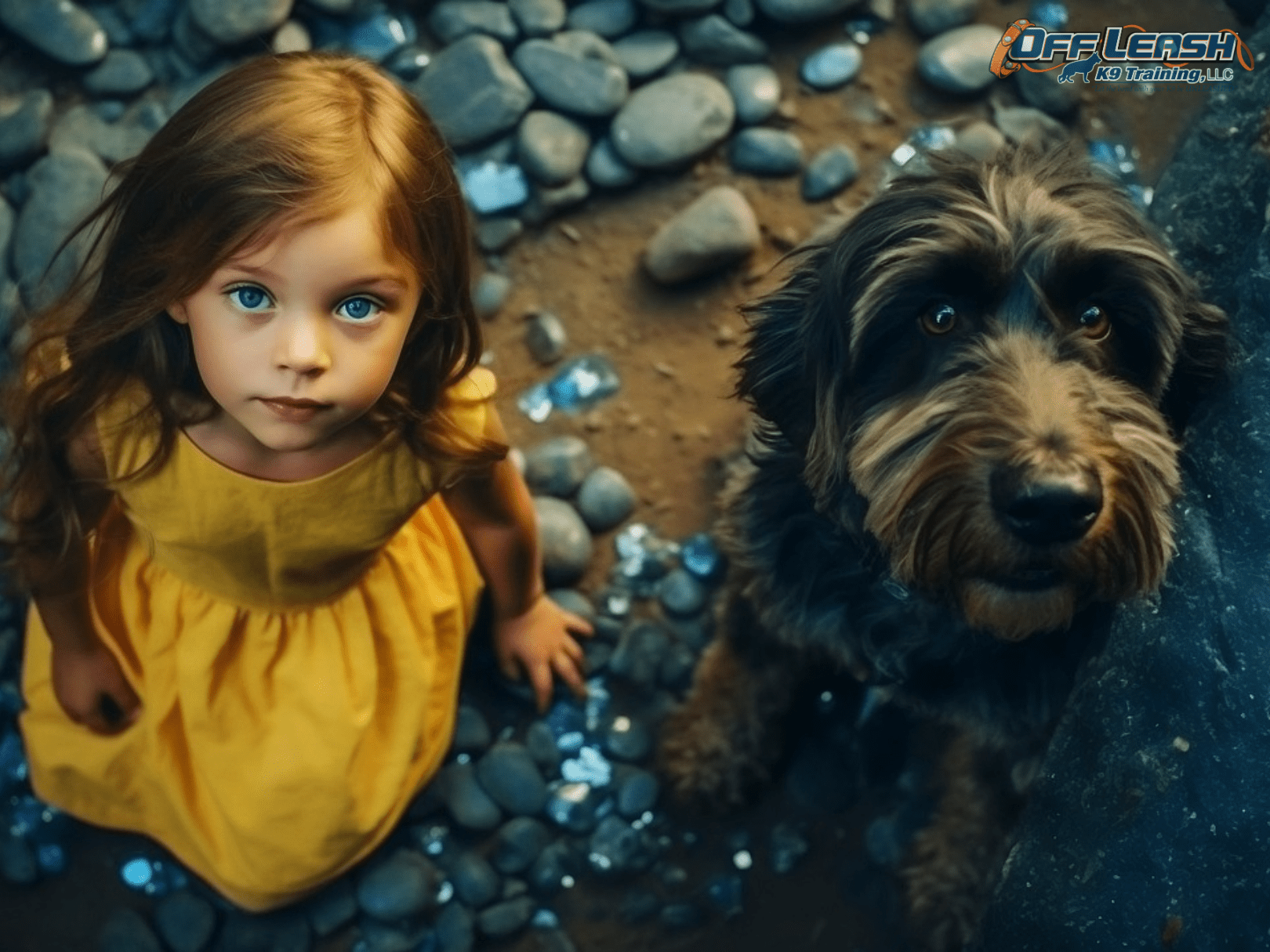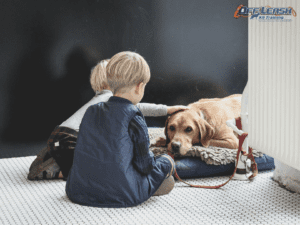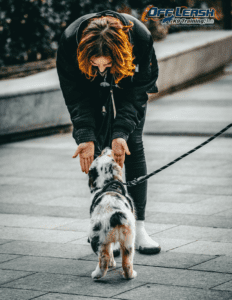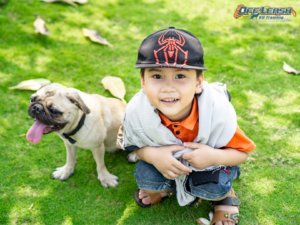Teach your children how to interact safely and positively with dogs, preventing accidents and fostering a harmonious bond between them, with expert guidance from Off Leash K9 Training of Phoenix.
Introduction: Importance of Teaching Children Dog Interaction
Educating children on the proper ways to interact with dogs transcends merely avoiding negative encounters; it lays the foundation for developing respectful and understanding relationships between young individuals and animals. Uninformed interactions can lead to unfortunate incidents, such as bites or scratches, which can instill a lasting fear or mistrust in children towards dogs. More gravely, these incidents can also result in trauma for the dog, potentially leading to a dog’s abandonment or euthanasia. Conversely, when children are taught from an early age how to engage with dogs respectfully, they not only ensure their safety but also cultivate a range of positive traits. These include empathy, as children learn to read and respect the feelings and boundaries of another being; responsibility, through caring for a pet’s needs; and patience, by understanding that building a relationship with a dog takes time and consistency.
Moreover, early education on dog behavior has been shown to significantly diminish the likelihood of conflicts between children and dogs. This proactive approach encourages a nurturing environment where children can safely explore the joys of companionship with dogs, while also learning invaluable life lessons. It’s about creating a symbiotic relationship that benefits both children and dogs, fostering a sense of mutual respect and understanding that resonates through their interactions. By prioritizing this education, we pave the way for a future where children and dogs coexist in harmony, enriching each other’s lives with the unique bond they share.
 Understanding Dog Boundaries
Understanding Dog Boundaries
Navigating the complexities of interactions between children and dogs, particularly in public spaces, can pose significant challenges. This is especially true for encounters with dogs that may be shy, anxious, or unaccustomed to the unpredictable behaviors of young children. A notable incident shared on Reddit serves as a poignant reminder of the potential risks involved. A child, unaware of the proper etiquette for approaching unfamiliar dogs, attempted to pet a dog without seeking permission from its owner. The dog, feeling threatened and cornered, almost resorted to biting as a defensive response. This incident not only highlights the importance of teaching children the critical lesson of not petting stranger’s dogs without explicit permission but also underscores the broader issue of recognizing and respecting a dog’s personal space and comfort levels.
To mitigate such risks, the adoption of visible indicators like muzzles or accessories in distinct colors (e.g., red leashes) has been suggested as a practical measure to signal a dog’s boundaries to others. These indicators can serve as clear, non-verbal cues that a dog requires additional space or may not be comfortable with unsolicited attention. Understanding and respecting these boundaries are fundamental to fostering a safe and positive environment for both children and dogs. It encourages a culture of mutual respect and consent, ensuring that interactions between our youngest members of society and our canine companions are conducted in a manner that prioritizes the well-being and comfort of both parties.
Initial Interactions with Dogs
Initiating the first contact with a dog sets the foundation for the future relationship between the child and the animal. It’s vital to teach children that their actions, such as avoiding rough play, or not waking a sleeping dog, play a significant role in building mutual trust and understanding. By teaching children to let the dog make the first move, we encourage them to observe and interpret the dog’s body language, fostering a deeper connection based on respect and empathy. This method not only ensures the safety of both parties but also imparts crucial lessons on patience and the importance of consent in interactions.
Moreover, these initial interactions serve as practical lessons in compassion and responsibility. For instance, explaining to a child why they shouldn’t disturb a dog while it’s eating or sleeping helps them understand boundaries and respect for others’ needs and comfort. Such experiences teach children to empathize with animals, recognizing them as sentient beings with their own likes, dislikes, and fears. This approach to teaching not only benefits the child and the dog but also prepares the child for respectful and understanding interactions with all living beings. Through these early lessons, children learn that kindness, patience, and responsibility are key to forming positive and lasting relationships.
Teaching Respect and Safety
Teaching respect and safety around dogs is an essential part of ensuring both children and dogs enjoy safe, positive interactions. From a young age, children should be educated on the importance of treating animals with kindness and understanding the signals dogs give to express their comfort or discomfort. This education includes teaching children to always ask for permission from a dog’s owner before approaching or petting the dog. Such an approach not only safeguards the child from potential harm but also respects the dog’s space and the owner’s understanding of their pet’s behavior [4]. Moreover, these lessons in empathy and consent extend beyond interactions with dogs, helping children develop respect for boundaries in all relationships.
Parents play a pivotal role in modeling respectful behavior towards animals. By demonstrating how to gently interact with dogs and heed the instructions provided by dog owners, parents set a practical example for their children. This guidance is crucial in teaching children that dogs, much like people, have their own set of boundaries that need to be respected. For instance, showing children how to calmly approach a dog , allowing the dog to sniff their hand before petting, and avoiding sudden movements can significantly reduce the likelihood of misunderstandings or accidents. These lessons in safety and respect are foundational, not only for preventing negative encounters with dogs but also for instilling a lifelong appreciation for the value of empathy and understanding towards all beings.
The Role of Parents and Dog Owners
The role of parents and dog owners in fostering safe interactions between children and dogs is critical and multifaceted. Parents must educate their children on how to approach and interact with dogs respectfully and safely. This education includes teaching children always to ask for permission before petting a dog, how to read basic dog body language to understand when a dog might be feeling scared or threatened, and the importance of not engaging in rough play or disturbing a dog when it’s eating or sleeping. On the other side, dog owners are responsible for ensuring their pets are well-behaved and under control in public spaces to prevent any accidents or negative encounters. This includes training dogs to respond to commands, keeping them on a leash in unfenced areas, and socializing them from a young age to be comfortable around children and other animals.
Furthermore, dog owners can take proactive steps to communicate their dog’s needs and boundaries to others, such as using visible indicators like color-coded leashes or harnesses to signify that a dog may need space from strangers. The collaboration between parents, children, and dog owners, supported by professional training and education, is essential in creating a safe and positive environment for everyone involved.
 Benefits of Growing Up with Dogs
Benefits of Growing Up with Dogs
The presence of dogs in a household can significantly contribute to a child’s physical and emotional development. Beyond the joy and companionship that dogs offer, growing up alongside these furry friends can lead to a stronger immune system in children. This benefit is attributed to the increased exposure to pet dander and other allergens, which can help children build up a natural immunity over time. Furthermore, this early exposure can reduce the likelihood of developing certain allergies and asthma, marking a significant health benefit of having dogs in the home.
Additionally, involving children in dog sports and activities not only provides a fun and engaging way to spend time together but also instills valuable lessons in teamwork, patience, and responsibility. Participating in dog sports can teach children about the importance of consistent training and the rewards of hard work. Moreover, educating children on the specific traits and needs of different dog breeds can foster a deeper understanding and appreciation for these animals. This knowledge allows children to anticipate their dog’s behavior and needs, leading to a more harmonious relationship between them. Through these interactions, children learn the importance of care, empathy, and mutual respect, enriching their emotional development and preparing them for compassionate interactions in all areas of life.
Preventing and Managing Negative Interactions
The foundation of preventing and managing negative interactions between children and dogs lies in the hands of both parents and dog owners. Parents play a critical role in educating their children on how to interact with dogs safely. One key lesson is teaching children to stand still if a dog charges towards them, as sudden movements can further provoke the dog, potentially leading to a dangerous situation. This approach not only protects the child but also gives the dog owner or handler an opportunity to regain control of the situation.
Equally important is the responsibility of dog owners to ensure their pets are leashed in public spaces. This measure is vital for preventing accidents and maintaining control over the dog’s behavior, especially in environments where children are present. Real-life incidents have highlighted the dire consequences of failing to leash dogs in public areas, from minor scares to severe injuries. These scenarios serve as a stark reminder of the importance of vigilance and responsibility in avoiding negative interactions.
Conclusion: Encouraging Safe and Positive Dog Interactions
The journey of teaching children to interact safely and positively with dogs is a crucial step in fostering mutual respect and understanding between kids and their furry friends. It’s not just about preventing bites or avoiding accidents; it’s about cultivating a relationship based on empathy, responsibility, and patience. By starting this education early, children learn to recognize and respect the boundaries of dogs, which in turn leads to fewer misunderstandings and conflicts. This education is not only beneficial for the immediate safety of children and dogs but also enriches the lives of both, building a foundation of compassion and care that extends beyond their interactions.
Off Leash K9 Training of Phoenix is a valuable resource in this educational journey. With their expertise in dog behavior and training, they offer a variety of services to help ensure that interactions between children and dogs are respectful, safe, and positive. Whether through private lessons or behavior consultations, their experienced trainers provide families with the tools and knowledge needed to foster harmonious relationships between their children and pets. For those looking to embark on this important educational journey, or to enhance their current practices, visiting https://phoenixk9trainers.com/ is a pivotal step towards ensuring the well-being and happiness of both children and their canine companions.


 Understanding Dog Boundaries
Understanding Dog Boundaries
 Benefits of Growing Up with Dogs
Benefits of Growing Up with Dogs